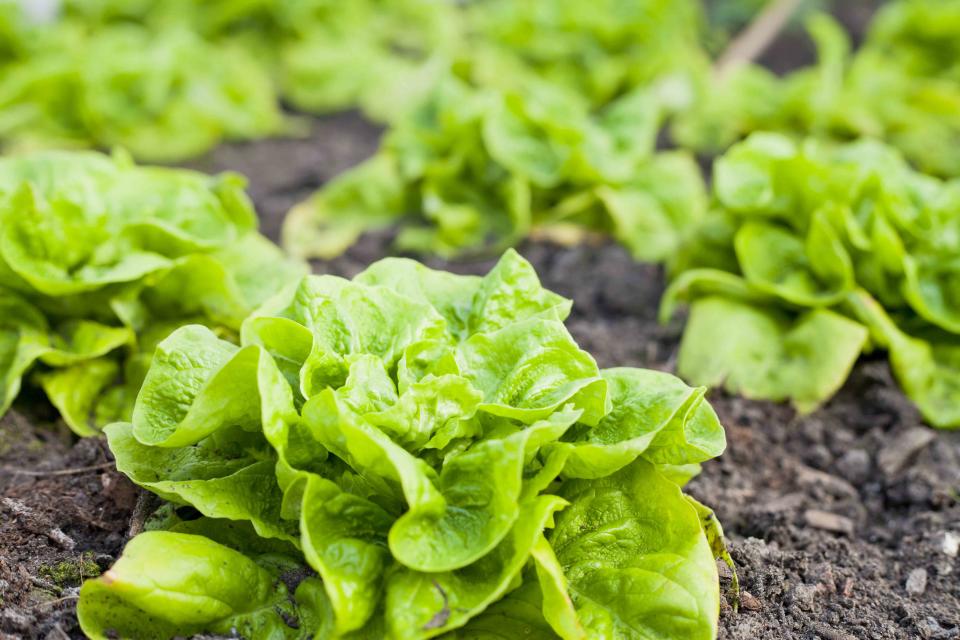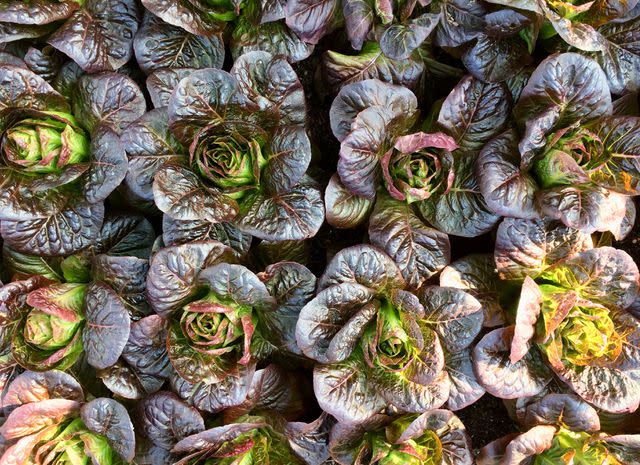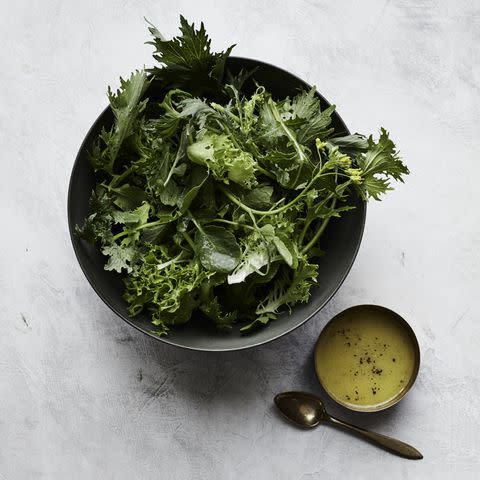How to Grow Lettuce for Crisp, Fresh Salads All Season Long
Lettuce is a fast-growing spring crop that is easy and convenient to grow at home.

joannatkaczuk / Getty Images
If your ideal meal includes beautiful salad greens harvested right from your garden, you're in luck. Growing lettuce at home is easy for even the novice gardener and can yield a season's worth of salad greens that can be the star of your meal or a refreshing side dish. Harvesting lettuce is easy; with no digging required—and for some varieties, you can simply harvest lettuce leaves as you go, taking just what you need for that day's meal. Ahead, we spoke with gardening experts to learn how to grow and care for lettuce, as well as harvesting, storing, and common problems you might run into when growing this plant.
Meet Our Expert
Ryan McEnaney, marketing and communications manager for Bailey Nurseries
Mary Jane Duford, certified master gardener
Luay Ghafari, garden consultant, educator, author of Seed to Table, and recipe developer
Related: Our Complete Guide to Starting a Vegetable Garden, From Planting to Harvesting
Types of Lettuce
You'll likely either be growing loose-leaf lettuce, or head lettuce in your garden. Of course, the type of lettuce you grow can depend on your specific USDA hardiness zone, so be sure to check the requirements before ordering seeds or seedlings. When growing lettuce, consider one of these varieties our experts love:
Little Gem
Buttercrunch
Tom Thumb
Winter Density
Marvel of Four Seasons
Bibb
Red Sails
Red Cross
Adriana
Sunland
When to Plant Lettuce
Lettuce is a cool-weather crop and can be planted in the spring once temperatures start hovering around 50 to 60 degrees Fahrenheit consistently, says Ryan McEnaney, marketing and communications manager for Bailey Nurseries. Some varieties of lettuce are a bit more heat tolerant than others (such as Little Gem and Sunland, for instance), but for the most part, you're going to want to plant lettuce in the early spring and harvest it in the late spring or early summer. You can even plant lettuce before the last frost, says Luay Ghafari, gardening consultant and author of the book Seed to Table.
Related: How to Plan Your Vegetable Garden the Right Way
How to Plant Lettuce
You can plant lettuce from seeds or seedlings and start them indoors if you wish before transplanting them outside. "Starting seedlings indoors allows for quicker seed germination in the early spring," says Mary Jane Duford, a certified master gardener. If you do decide to start them indoors, you'll want to make sure you harden them off before transplanting them outside, says McEnaney.
Sowing Lettuce Seeds
Sowing lettuce seeds directly is the preferred method of growing lettuce at home.
Make shallow rows for your lettuce seeds, about 8 to 12 inches apart.
Sow the seeds in tiny, pinched clusters about 4 inches apart.
Plant the seeds only about 1/4-1/8 of an inch into the soil.
Water thoroughly.
Lettuce has a very shallow root system, so you don't need to sow seeds too deep for them to thrive into healthy lettuce plants. "Seeds should be about 1/8" below the surface, so it’s a really shallow planting," says McEnaney. "If planting by seed, you can space them every 3-4 inches, but will need to thin them as the plants grow in, keeping only the strongest seedlings."
When thinking about your spacing, you'll want to consider whether you're planting loose-leaf or head-forming lettuce. "Leaf lettuce plants are typically planted closer together than head lettuce plants," says Duford. Full-grown head lettuce plants are generally spaced about 12 inches apart (center to center), but you can plant them every 4 to 6 inches and harvest alternate plants at a mini-head stage."
If you start your lettuce seeds indoors, you'll see seedlings emerge within two to three days as long as the seeds are kept in a warm, humid environment, Duford says. Plan on a longer time for seedlings to emerge if sown directly outside, though. "Lettuce seeds typically germinate well in the range of 40 degrees to 80 degrees, but germination is slow at the cooler end of this range," she says. "Seedlings might take a week to emerge after planting the seeds in 50-degree soil but will likely take at least two weeks to sprout if the soil stays below about 40 degrees."
Planting Lettuce Seedlings
Another option is to plant slightly more mature lettuce seedlings to speed things up. Here, reading the tag is important to understand spacing. "If you’re planting more established plants from a garden center, allow them enough space to fully grow in with room for airflow, as directed by the tag," says McEnaney.
Related: 7 Fast-Growing Vegetables to Plant in Early Spring, According to Martha’s Head Gardener

Ten Mothers Farm
Caring for Lettuce
To ensure your lettuce crop is strong and healthy, you'll want to maintain ideal growing conditions.
Soil
Lettuce plants prefer well-draining, loamy soil as close to a neutral pH as possible (between 6.0 and 7.0). Lettuce can also do well in containers with potting soil, because of its shallow root system.
Sunlight
Most lettuce plants need full or partial sun to thrive. Lettuce does not grow well in the shade. "The sun will help the lettuce grow more quickly, which is especially important to maximize harvests," says McEnaney.
Water
Keep your lettuce plants well-watered, but not so much that you water-log them. Check your plant's soil a few times a week, watering when the soil is dry down to an inch deep. Container lettuce plants may need water more frequently as the soil can dry out faster.
Temperature
Lettuce is a cool-weather crop, so it thrives when the air temperature is consistently between 60 and 65 degrees Fahrenheit. You'll want to plant and grow lettuce in the spring and fall, though some heat-tolerant varieties (such as Jericho) can make it through the summer with some assistance (like planting in a bit more shade to avoid getting scorched by afternoon sun or using a shade cloth for extremely hot days, says Ghafari).
Related: The Best Companion Plants for Peppers, Plus Tips to Ensure a Flourishing Crop
How and When to Harvest Lettuce
Lettuce grows quickly and is usually ready to harvest in six to eight weeks for head varieties, and as little as a month for loose-leaf varieties. "What’s great about growing lettuce in the home garden is that you don’t have to harvest it all at once," says Ghafari. "You harvest what you need for lunch or dinner, leaving the rest in the ground."
Another thing to consider is that you'll want to harvest your lettuce leaves before the plant bolts, or shoots up a central stem. When lettuce bolts, it becomes bitter. "This happens if you don’t begin to harvest as leaves mature or when the temperature starts to heat up regularly," says McEnaney.
Loose-Leaf Lettuce
Clean your garden shears carefully before harvesting lettuce leaves to avoid any potential cross-contamination.
Using clean garden shears, cut mature lettuce leaves close to the stem.
Work from the outside in, which will allow the inner leaves to continue growing and maturing.
Head Lettuce
Clean a lettuce knife or serrated knife well with soap and water.
Wait until the head of lettuce is fully mature and the center feels firm to the touch.
Cut the lettuce at the base of its stem at the soil line.
Chill immediately.

Storing Lettuce
Fresh lettuce is best eaten right after harvesting, but if you have a big crop of lettuce, you'll want to store it correctly. Store unwashed lettuce leaves in your refrigerator. When you're ready to eat them, wash them thoroughly and dry them off.
Related: The Right Way to Wash Every Type of Vegetable, According to Food Safety Experts
Common Problems When Growing Lettuce
Be on the lookout for certain pests and diseases when growing lettuce, especially if you're growing it directly in a garden bed. "Common garden pests that attack lettuce plants include slugs, aphids, earwigs, flea beetles, and cutworms," says Duford. "Common diseases include fungal pathogens like powdery mildew and Botrytis blight."
You may also want to erect physical barriers if you live in an area with deer and squirrels. "Rabbits and deer are also problematic, and I would recommend using physical barriers like fencing to protect your crop," says Ghafari. "Raccoons and squirrels are more of a nuisance and will destroy your garden in search of grubs and nuts. Physical barriers work well." Ghafari also suggests planting your lettuce in raised containers like pots to keep them from ground-level pests like slugs.
Treating some of these issues is easy though—vigilance is key. "Aphids can be treated with a natural fungicide or by co-planting with chives, which naturally repel the insect," says McEnaney. "Slugs can be treated with organic slug pellets, an organic bacterium spray, or by placing a shallow container of beer in the landscape. It sounds weird (and maybe not as pleasant of a demise for the slug), but it works!"
Related: How to Keep Squirrels Out of Your Garden
Read the original article on Martha Stewart.

